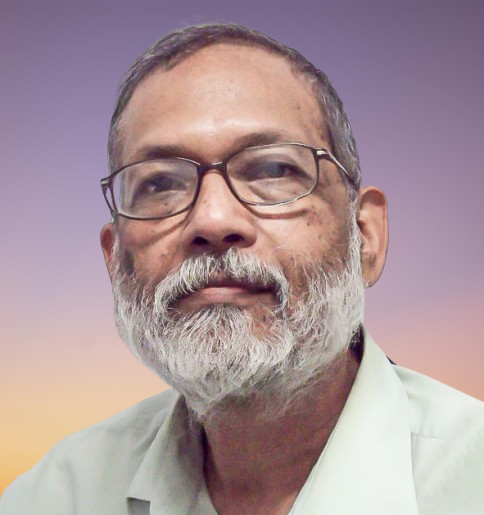Column

Humayun Ahmed. Photo: Collected
There are few people in literature anywhere who were so representative of their class, culture and aspirations as Humayun Ahmed. Nor anyone so well loved. His novels not only reflected his time but also shaped the mentality of generations of youth. He could touch his readers and later the viewers of his work so deeply that they would come down to the streets demanding the change of some of his story endings. He would in his later life become a filmmaker too but in the end he was the most supremely popular writer ever of Bangladesh.
Constructing the reader
The world he wrote about is the world of the Bengali middle class of the 70s and later the 80s . But in many ways he created an alternate world in which his readers found themselves, in an almost infinite space of imagination serving as reality.
The character of the early Humayun Ahmed works is the soft and shy middle class of Bangladesh. Those who love a little, live a little, whose life's ambitions are also limited. But he presented his characters in such a way that his reader's imagination was captured and then expanded. There lies the success of Humayun Ahmed. There was little demarcation between when his characters' world ended and his readers began.
Sketching the post 1971 middle class world
Humayun Ahmed started writing soon after independence. That is why he was a transitional being and a writer. His father was a policeman who was killed by the Pakistan Army. Humayun was a good student and in an interview published in Bichitra many years ago, he said that his education was the basis for his next life activities.
He was one of the best students in the country. Becoming a teacher in Dhaka University was his destiny and he became it. But later in life he left that job to become a full-fledged writer and filmmaker, overcoming the economic and social limitations of his class.
This was very significant. It happened two decades after 1971, when the old middle class was already in serious transition and so was he. He was part of this evolving middle class and his own life and literature reflected that. Writer Humayun Ahmed did not go beyond his class because he didn't have to. His integrity lies in being faithful to his roots.
Sketching the psyche
Those who have read 'Nandit Narake' and 'Shankhneel karagar' will know that he was realistic in these two highly successful novels. He turned his experiences into art. But his achievement is that he also understood that the class he represented and for whom he wrote was changing. That is why the changes in his writings created a new range later on.
He created many characters, which are firmly placed in the psyche of his readers, certainly more than real life ones. He didn't just show reality, he showed dreams too and mixed the contradictions adroitly. He says to his reader, 'Look at you but look at how you want to look also.' Readers and viewers agreed. In a real sense, he was an architect of the collective middle class mind.
TV serials to buy a TV
Humayun Ahmed was a very harmless academic and very popular writer till TV hit him. It is heard that he wrote his breakthrough TV serial 'Ae Sab Dinratri' to buy a new television. As those who have seen it will know, it was not only a reliable reflection of the Bengali middle class of the 70s, it reminded them that they exist, that they survive despite a hundred obstacles and became their anthem.
The importance of Humayun Ahmed's literature is often discussed. But he was more than a writer, a cultural choreographer who transcended the limits of literature. He single handedly created an entire literary genre, market, readership with their iconic characters and ideas. Greater success than this is not possible.
Very few writers have reached so many people in Bengali literature as he did. Although he considered Sunil Ganguly as a role model as he once told me, it was Humayun Ahmed who brought Bangladeshi readers home. In a sense, today's readers are mostly his creation.
The yellow Punjabi syndrome
There is no way to understand where Humayun Ahmed ends and his character begins. He created people like Himu, Misir Ali and others, who are eccentric characters, exceptional characters unlike the typical middle class Bangladeshi. Almost no one gets hanged like Baker bhai brother. But they not just brought people to the streets but made eccentricity a little more respectable and acceptable. Its the first hint of social transition and his characters led the march.
When people take to the streets to save the life of a fictional character, we can understand how deeply influential his literature was. He himself changed as did the middle class, no longer timid and proper but doing exactly what would be taboo in his earlier fiction.
He too changed and so did his class and his literary characters. They all merged to become part of a single mural called Bangladesh middle with the vivid colours of his creative imagination. He truly transcended and remains there still.

























Leave a Comment
Recent Posts
Right On Schedule
The most eagerly anticipated, and frankly hyped up, announcement of an ...
Fighting raged along the borde ...
Fighting raged along the border of Cambodia and Thailand, with explosi ...
ICIMOD drives regional cooperation to inspire new mo ..
The Cage of Captivity and the Cry for Freedom: A Cru ..
Why Japan issued an advisory for a possible megaquak ..
The Autocrats’ War on Universities